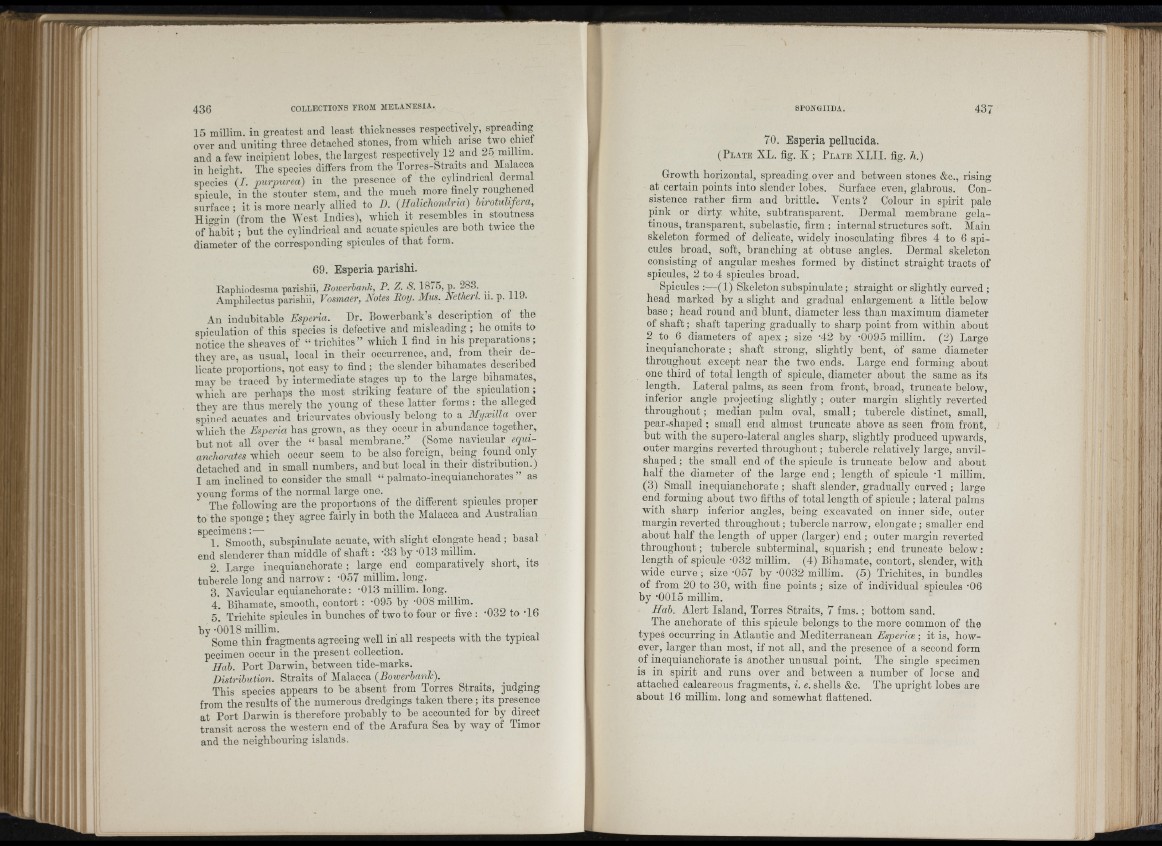
i i
Ji
! i:
i. J
15 millim. in greatest and least thicknesses respectively, spreading
over and uniting three detached stones, from which arise two chief
and a few incipient lobes, the largest respectively and A5 milLim.
in heio-ht. The species differs from the Torres-Straits and Malacca
species (I. purpurea) in the presence of the cylindrical dermal
spicule, in the stouter stem, and tho much more finely roiighenc
surface ; it is more nearly allied to D. {Halichondria) hirotulifera,
Hio-o-in (from the ^Yest Indies), which it resembles in stoutness
of h a b it; but the cylindrical and acuate spicules are both twice the
diameter of the corresponding spicules of th a t form.
69. Esperia parishi.
Ttapliiodesma parish ii, Boiverhank, P. Z, S. 18/5, p. 283.
Amphilectus parishii, Vosmaer, Notes Boy. Mus. Netherl. ii. p. 119.
Dr. Bowerbank’s description of the
An indubitable Esperia. _ _
spiculation of this species is defective and misleading ;
notice the sheaves of “ trich ites” which I find in his p;
he omits to
preparations;
they are as usual, local in their occurrence, and, from their delicate
proportions, not easy to find ; tho slender bihamates described
may bo traced by intermediate stages up to the large bihamates,
which are perhaps the most striking feature of the spiculation ;
they are thus merely the young of these latte r forms: the alleged
spilled acuates and tricurvates obviously belong to a Alyxilla over
which the Esperia has grown, as they occur in abundance together,
but not all over the “ basal membrane.” (Some navicular equi-
anchorates which occur seem to he also foreign, being _ found only
detached and in small numbers, and hut local in their distribution.)
I am inclined to consider the small “ palmato-inequianchorates ” as
young forms of the normal large one.
The following are the proportions of the different spicules proper
to the sponge ; they agree fairly in both the Malacca and Australian
specimens;— _ i -i v i
1. Smooth, siihspinulate acuate, with slight elongate head; basal
end slenderer than middle of s h a ft: *33 by '013 millim.
2. Large ineqnianchorate ; large end comparatively short, its
tubercle long and narrow : -057 millina. long.
3. Nav icu la r e q u ia n c h o ra te : -013 millim. long.
4’. Bihamate, smooth, co n to rt; -095 by -008 millim.
5. Trichite spicules in hunches of two to four or five : -032 to -16
by -0018 millim. . .
Some thin fragments agreeing well in all respects with the typical
pecimen occur in the present collection.
Hab. Port Darwin, between tide-marks.
Distrihution. Straits of Malacca {Bowerhank).
This species appears to be absent from Torres Straits, judging
from the results of the numerous dredgings taken there ; its presence
at Port Darwin is therefore probably to be accounted for by direct
transit across the western end of the Arafura Sea by way of Timor
and the neighbouring islands.
70. Esperia pellucida.
(P l.y te XL. fig. K ; P l a t e XL II. fig. h.)
Growth horizontal, spreading over and between stones &c., rising
at certain points into slender lobes. Surface even, glabrous. Consistence
rather firm and brittle. Yents? Colour in spirit pale
pink or dirty white, suhtransparent. Dermal membrane gelatinous,
transparent, subelastic, firm ; internal structures soft. Main
skeleton formed of delicate, widely inosculating fibres 4 to 6 spicules
broad, soft, branching at obtuse angles. Dermal skeleton
consisting of angular meshes formed by distinct straight tracts of
spicules, 2 to 4 spicules broad.
Spicules :—(1) Skeleton subspinulate; straight or slightly curved ;
head marked by a slight and gradual enlargement a little below
ba se ; head round and blunt, diameter less than maximum diameter
of sh a ft; shaft tapering gradually to sharp point from within about
2 to 6 diameters of a p e x ; size -42 by -0095 millim. (2) Large
inequianchorate; shaft strong, slightly bent, of same diameter
throughout except near the two ends. Large end forming about
one third of total length of spicule, diameter about the same as its
length. Lateral palms, as seen from front, broad, truncate below,
inferior angle projecting slightly ; outer margin slightly reverted
th ro u g h o u t; median palm oval, small; tubercle distinct, small,
pear-shaped ; small end almost truncate above as seen from front,
but with the supero-lateral angles sharp, slightly produced upwards,
outer margins reverted throughout; tubercle relatively large, anvil-
shaped ; the small end of the spicule is truncate below and about
half the diameter of the large end ; length of spicule ‘I millim.
(3) Small ineqnianchorate ; shaft slender, gradually curved ; large
end forming about two fifths of total length of spicule ; lateral palms
with sharp inferior angles, being excavated on inner side, outer
margin reverted throughout; tubercle narrow, elongate; smaller end
about half the length of upper (larger) end ; outer margin reverted
throughout; tubercle snhterminal, squarish ; end truncate below :
length of spicule '032 millim. (4) Bihamate, contort, slender, with
wide curve ; size -057 by -0032 millim. (5) Trichites, in bundles
of from 20 to 30, with fine points ; size of individual spicules '06
by '0015 millim.
Hah. Alert Island, Torres Straits, 7 fms. ; bottom sand.
The anchorate of this spicule belongs to the more common of the
types occurring in Atlantic and Mediterranean Esperice; it is, however,
larger than most, if not all, and the presence of a second form
of inequianchorate is another unusual point. The single specimen
is in spirit and runs over and between a number of lorso and
attached calcareous fragments, i. e. shells &c. The upright lobes are
about 16 millim. long and somewhat fiattened.
k;
■■'lid'